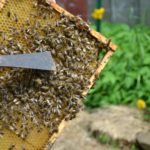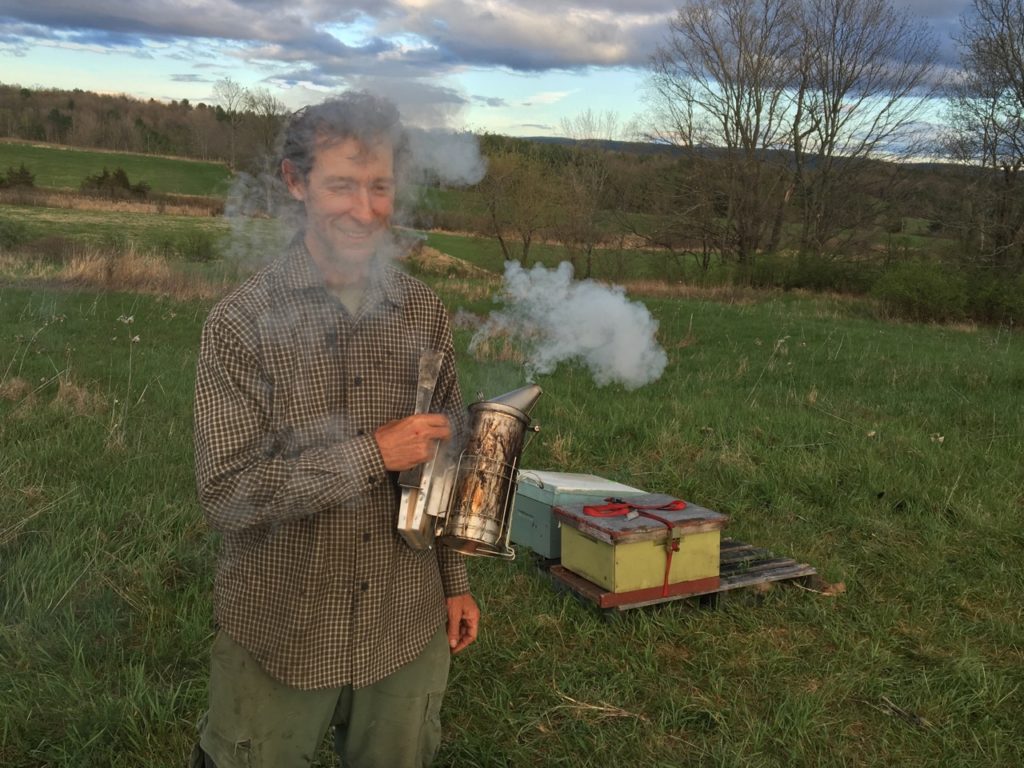Honey bees on the farm will pollinate our flowers. Todd began a relationship with honey bees over 50 years when he and his brother Tom, 9 years old, bought their first hive for their family farm. They were enchanted by how industrious the bees were, giving them honey, pollen, propolis and beeswax for candles and salve. Around 40% of what is eaten is pollinated by insects, this to a great degree by honey bees. Because there are so few nectar & pollen plants on Thornhill Farm, we are planting these plants for the bees. We know the soil is worn out on the farm because our honey bees make so little honey. This is why we have pigs. When the forest is cleared, we do not burn the wood that is left behind, but chip it and mix these wood chips with manure and fungus mycelium to make piles of compost to improve the soil. Last summer we grew peas and oats as a green manure crop, and the pea flowers gave voluminous amounts of nectar to the honey bees and pollinating insects.
Health & the Hive: A Beekeeper’s Journey
 A Jan Cannon Film that explores the importance of honeybees in our lives through the seasons of Honey Gardens Apiaries, Todd and the team. Topics addressed in the film include pollination, queen breeding, disease control, bee venom therapy, organic agriculture and honey-based plant medicine. 53 minute dvd. $10 + $4 (shipping).
A Jan Cannon Film that explores the importance of honeybees in our lives through the seasons of Honey Gardens Apiaries, Todd and the team. Topics addressed in the film include pollination, queen breeding, disease control, bee venom therapy, organic agriculture and honey-based plant medicine. 53 minute dvd. $10 + $4 (shipping).
to order, send a check to: 198 Taylor Road, Greensboro Bend, Vermont 05842
writings & images about the honey bees of Thornhill Farm
- Tim McFarline, McFarline Apiaries, Benson, Vermont June 3, 2016

Tim McFarline, McFarline Apiaries, Benson, Vermont. Tim raises queen bees organically from survivors and sells colonies of bees each Spring. We worked together for six years. May 2016.
Live from the Hive by Annie Watson – Winter 1997 to July 2015 archives
- Live From the Hive: July 2015“The Mints” by Annie Watson, Thistle Hill Studio Honey bees love the flowers of the mint family (Lamiaceae). Spearmint, catmint, lemon balm, catnip… the list goes on. Did you know that basil is in the mint family? So are lavender, oregano, and rosemary. In our area, the mints bloom in June and July. Pollinators are threatened all ...
- Live from the Hive: June 2015“Staghorn sumac bloom” by Annie Watson, Thistle Hill Studio June brings the blooming of the staghorn sumac. Its beautiful flowers are a major food source for honey bees. I’ve seen them covered with bees on a warm June afternoon. Largest of the North American sumacs at 15-25 feet tall, Staghorn sumac is named after the” velvet” on ...
- Live From the Hive: May 2015“Dandelions” by Annie Watson, Thistle Hill Studio In May the dandelions bloom, providing nectar and pollen to the growing numbers of bees in strong colonies. The bees are out in numbers on the warm days, gathering food for their growing families. Dandelions are amazing plants with many medicinal properties. Their masses of blooms all over New England ...
- Live from the hive: April 2015“First pollen and nectar” by Annie Watson, Thistle Hill Studio Spring has arrived! We are so grateful for sunshine and warmer days. April is a big month for honeybees. The newly available pollen and nectar support their building of a strong, well-populated colony that can make lots of honey to — yes — get them through ...
- Live from the hive: March 2015“Until the Next Bloom” by Annie Watson, Thistle Hill Studio It was a difficult winter for the bees. At my house in the Champlain Valley, only one out of three colonies remains alive. We gave them a super of honey, and hope that they will make it through. My beekeeper friend Bob writes: “Out of 16 colonies, ...